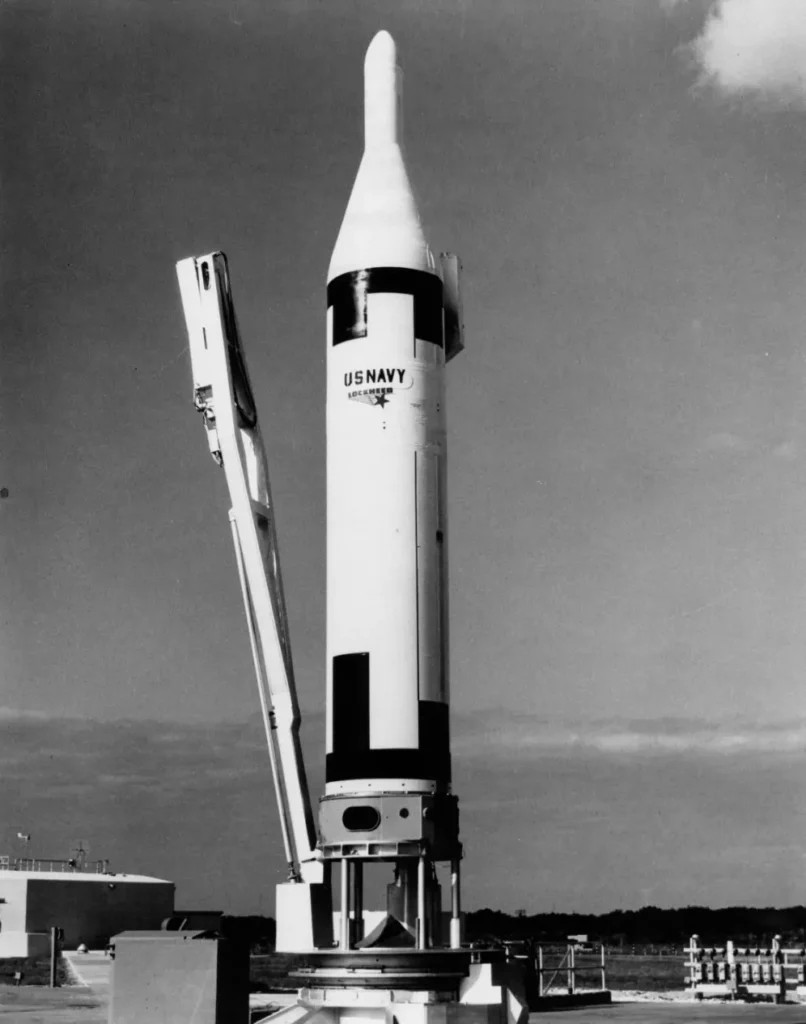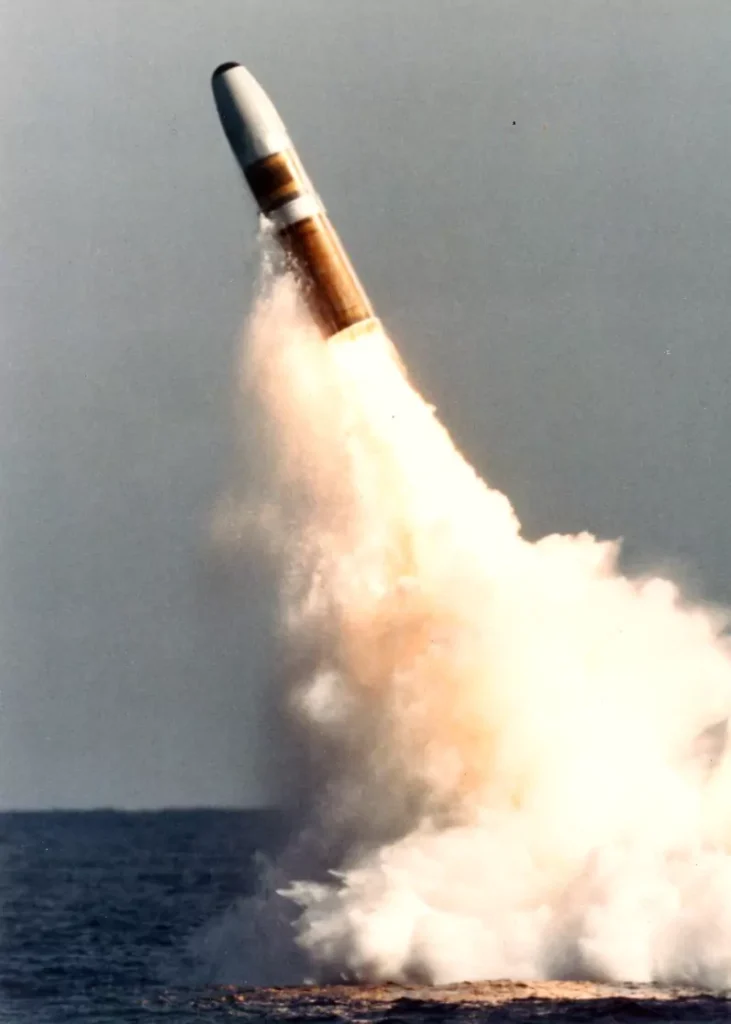Introduction
Submarine-Launched Ballistic Missiles (SLBMs) have marked a significant evolution in the United States Strategic Nuclear arsenal since the 1960s.
Initially, the first-generation Polaris missiles had such a short range that the operational scope was limited to the North Sea and the Mediterranean, making them more vulnerable to Soviet ship attacks.
However, with the introduction of the Polaris A3 in 1964, submarines could relocate to the North Atlantic. This technological leap allowed for a considerable increase in survivability due to the expanded operation region and immunity from attacks. This development marked the beginning of the SLBMs’ growing importance within the U.S. Strategic arsenal.
| Missile | Range (n.m) | IOC | Warhead |
|---|---|---|---|
| Polaris A-1 | 1,200 | 1960 | 1 x W-47 600 kt |
| Polaris A-2 | 1,500 | 1962 | 1 x W-47 1.2 Mt |
| Polaris A-3 | 2,500 | 1964 | 3 x W-58 200 kt |
| Poseidon C-3 | 2,500 | 1971 | 10-14 x W-68 50 kt |
| Trident I C-4 | 4,000 | 1979 | 8 x W-76 100 kt |
| Trident II D-5 | 4,000+ | 1990 | 8 x W-76 100 kt 8 x W-88 475 Kt |
Presently, thanks to continual advancements, SLBMs have become the primary strategic nuclear weapon of the U.S.
The modern SLBMs have not only seen improvements in range but also in accuracy and payload, matching the nuclear capability of land-based Intercontinental Ballistic Missiles (ICBMs).
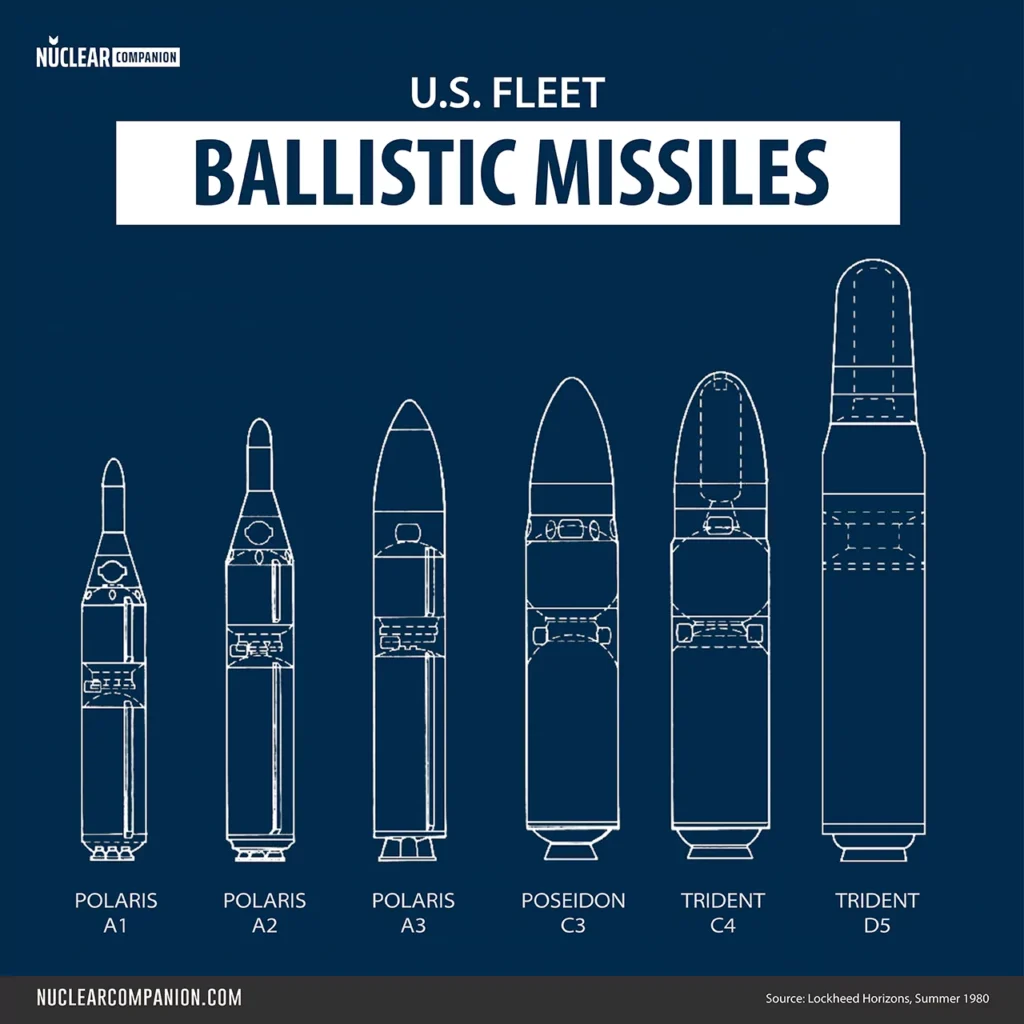
For instance, Trident submarines can launch missiles from Kings Bay, Georgia, reaching targets in Eastern Europe with an explosive yield far surpassing the bomb dropped on Hiroshima and an impressive accuracy within a hundred yards of its target.
This remarkable destructive power is the outcome of over thirty years of technological evolution that we will analyze in the next section.
Missiles
Since 1960, the US Navy has deployed six generations of submarine-launched ballistic missiles (SLBMs) as a crucial component of its strategic deterrence.
The journey began with the first-generation Fleet Ballistic Missile (FBM) Polaris (A1) during the initial Cold War era. This lineage subsequently evolved through Polaris (A2), Polaris (A3), Poseidon (C3), and Trident I (C4), culminating in the current Trident II (D5).
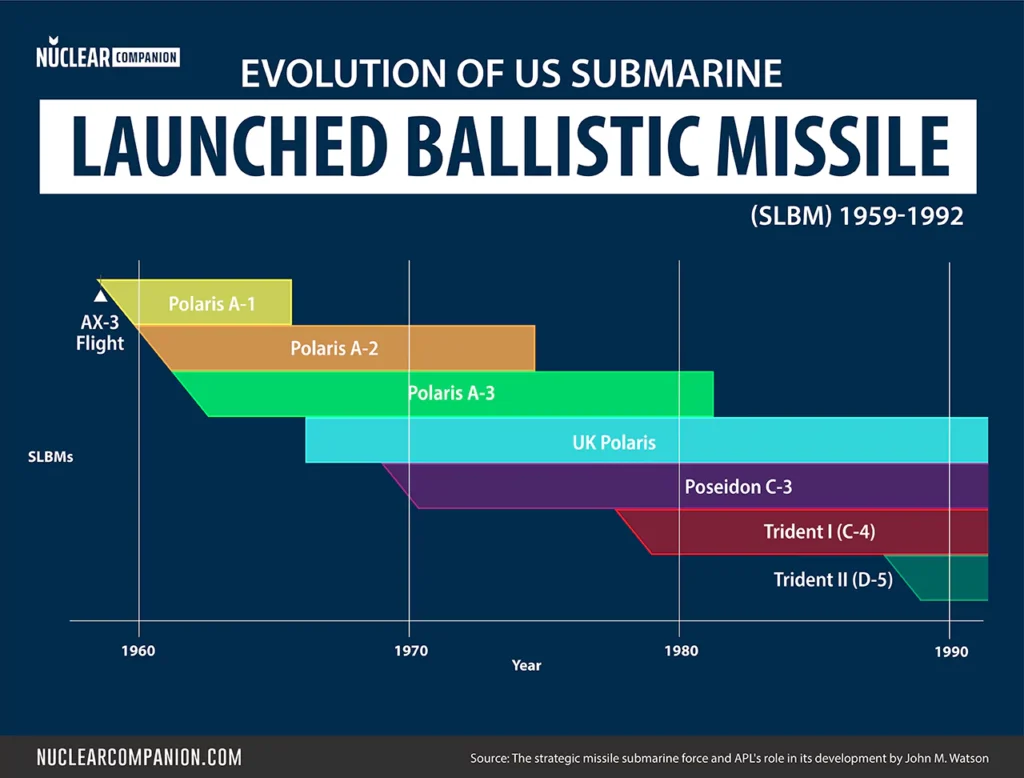
Each new generation boasted advancements over the earlier ones, improving range, precision, and payload capacity.
Polaris A-1
The Polaris A-1, named after the North Star, was the first SLBM deployed by the United States, and the world’s first long-distance missile powered by solid-propellant rocket motors.
This missile with its two stages was 28 feet long, 4 feet in diameter, and weighed roughly 30,000 pounds. It had a range of 1,200 nautical miles and its inertial guidance system functioned without any external control.
Both of its motors directed thrust via four nozzles at the base, with Jetavators managing the direction. The motors were encased in steel.
The first underwater test launch was carried out by the USS George Washington (SSBN-598) off Cape Canaveral, Florida, on 20 July 1960.
Interested in reading more about the Polaris A-1? Continue to our article about this missile.
Polaris A-2
The Polaris A-2, while resembling the A-1 in appearance and diameter, had a range of 1,500 nautical miles and was 30 inches longer.
It was designed based on the original Polaris specification for a missile with a 1,500-nautical mile range and a 1 Mt warhead.
It used a more potent solid propellant than the A-1. Unlike the A-1’s steel motor case, the A-2’s second-stage rocket motor case was made from wound glass fiber, and it employed rotating nozzles instead of jetavators.
The USS Ethan Allen (SSBN-608) successfully tested the A-2 missile while submerged off Florida’s coast on 23 October 1961.
More information on our Polaris A-2’s article.
Polaris A-3
The Polaris A-3 marked the ultimate design of the Polaris SLBM, with its operational successor being the substantially larger Poseidon C-3 missile.
The A-3 made a more substantial progression from the A-2 than the A-2 did from the A-1, with about 85% of the A-3 being a new design.
Its standout feature was the incorporation of the Multiple Reentry Vehicle (MRV) technology, enabling it to disperse three warheads, each with a 200-kiloton yield, over a broader destruction zone than a single warhead. Essentially, the A-3’s MRV “shotgunned” its three warheads toward a single target.
The inaugural submerged launch of the A-3, with its 2,500 nautical mile range, was conducted by the USS Andrew Jackson (SSBN-619) off Florida’s coast on 26 October 1963.
Want to know more? Continue to our article about the Polaris A-3 missile.
Poseidon C-3
The Poseidon C-3, named after the Greek sea god, was substantially larger than its predecessors.
At 34 feet in length and 74 inches in diameter, it was 2 feet longer than the Polaris A3 and had a diameter that exceeded the A3’s by 20 inches.
Moreover, it weighed 30,000 pounds more. Remarkably, despite its increased size, it was compatible with the same launch tubes that housed the Polaris missiles on FBM submarines.
Poseidon was the world’s first operational missile equipped with Multiple Independently targeted Reentry Vehicles (MIRV).
The missile had the capacity to carry ten to fourteen W-68 thermonuclear warheads, each boasting a yield of 50 kilotons. These warheads could be dispatched to individual targets within a defined region or “footprint”. With their quick flight time, they had the potential to saturate Soviet ABM defenses, targeting “soft” military installations, and key urban/industrial centers.

With a full load of fourteen warheads, the missile’s range was approximately 1800 miles. However, reducing the number of warheads could extend this range to a maximum of 3000 miles. For 10 warheads, the range was 2,500 miles.
The USS James Madison (SSBN 627) achieved the first submerged Poseidon missile launch off Florida’s Cape Canaveral coast on August 3, 1970.
Read more about the Poseidon C-3 missile in our article about it!
Trident I C-4
The Trident C-4, initially termed EXPO (Extended-range Poseidon), emerged in the early 1970s as a final version of the Polaris/Poseidon lineage.
Intended as a temporary measure until the Trident D5 was ready, the Trident C4 was adapted to fit both existing Poseidon and the new Ohio-class submarines, the latter of which allowed for even larger missiles than the C4.
The primary design objective of the Trident C4 missile development was to extend the range of submarine-launched missiles, enabling a broader patrol zone.
With almost the same dimensions as the Poseidon, the Trident I C4 weighed 70,000 lbs and was a three-stage, solid propellant missile. It could carry eight Mark 4 100Kt MIRV warheads to destinations up to 4,000 miles from its firing point.
The first Trident C4 submarine launch from a submarine, the Francis Scott Key (SSBN 657), was on 10 April 1979.
A more complete description and history of the Trident II C-4 can be found here.
Trident II D-5
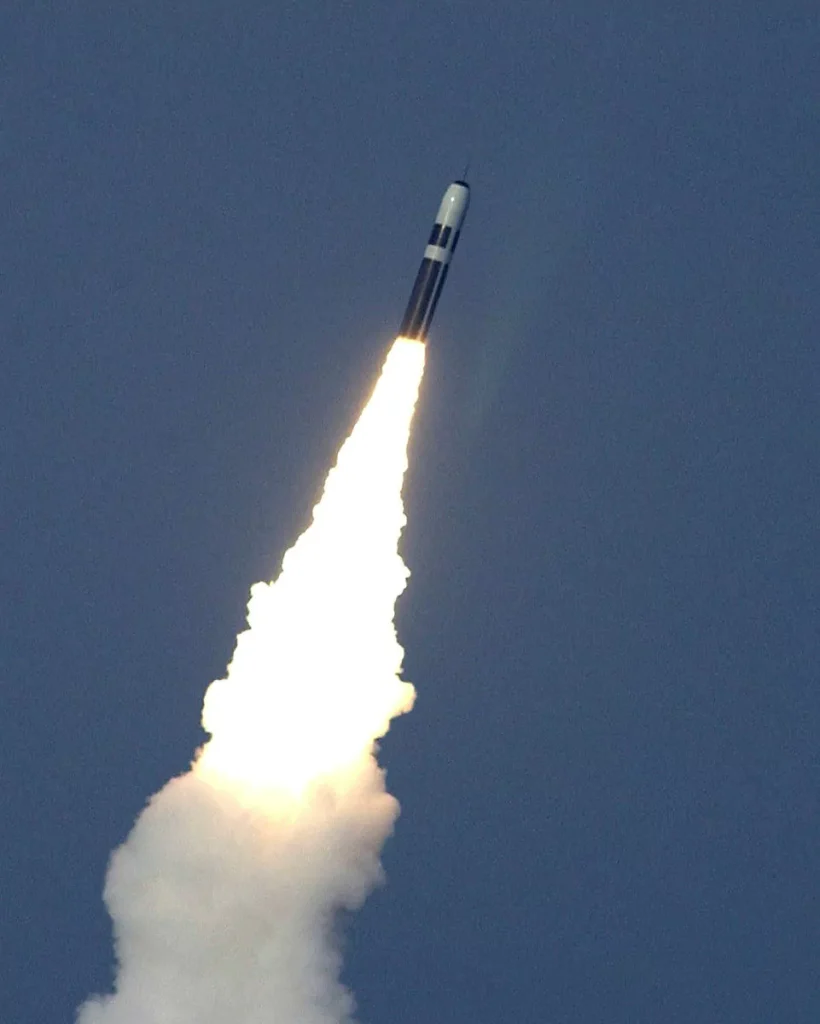
The Trident D-5 stands as the ultimate U.S. submarine-launched ballistic missile, offering enhanced range and precision over earlier SLBMs.
It is the largest and heaviest SLBM deployed by the U.S. Navy, taking advantage of the size of the Ohio-class submarines.
Trident D5’s design objective was to increase the number of reentry vehicles to a Poseidon C-3 level with a range similar to Trident C4 increasing the accuracy.
In fact, its accuracy surpasses that of its contemporary U.S. land-based ICBMs.
With a guidance system capable of positioning fourteen light warheads (100 kilotons) within a 300-foot (90 m) radius at distances up to 4,100 nautical miles (7,600 km), the D-5 can also carry eight heavy (475 kilotons) nuclear warheads. With fewer warheads, the maximum range is 6,200 nautical miles.
Despite facing challenges and multiple launch failures during its development, the Trident D-5 became operational aboard the USS Tennessee (SSBN 734) in March 1990.
If you are interested in reading more about this missile, continue to our Trident II D-5 information article.
Patrol Deployments
The United States executes a continuous at-sea deterrent strategy, ensuring submarines are always on patrol. This approach greatly enhances system invulnerability as it prevents all submarines from being docked at the same time, thereby averting exposure to potential threats.
The policy took off with Polaris-equipped submarines embarking on two to three-month-long strategic patrols from bases in Holy Loch, Scotland, and Rota, Spain. The introduction of Poseidon missiles in 1968, allowed for further distanced patrols from the Soviet Union, expanding coverage, and reducing travel distance.

The subsequent deployment of Trident submarines significantly enhanced this strategy, leading to a 21% surge in the at-sea patrol time of the SLBM force due to their shorter refit periods, thus strengthening the United States’ strategic defense.
| Missile | First Patrol began | Last Patrol completed | Total Patrols |
|---|---|---|---|
| Polaris A-1 | USS George Washington (15 Nov 1960) | USS Abraham Lincoln (14 Oct 1965) | 83 |
| Polaris A-2 | USS Ethan Allen (26 June 1962) | USS John Marshall (9 June 1974) | 338 |
| Polaris A-3 | USS Daniel Webster (28 Sep 1964) | USS Robert E. Lee (1 Oct 1981) | 844 |
| Poseidon C-3 | USS James Madison (31 Mar 1971) | USS Kamehameha and USS Ulysses S. Grant (1 Oct 1991) | 1,182 |
| Trident C-4 | USS Francis Scott Key (20 Oct 1979) | USS Michigan (15 Dec 2003) | 887 |
| Trident D-5 | USS Tennessee (29 Mar 1990) | (missile in service) | 500+ |
On September 26, 2008, the USS Pennsylvania (SSBN 735) concluded the Ohio-class submarine Trident II D5’s 500th successful patrol.
Further reading
- Polaris A-1 (UGM-27A)
- Polaris A-2 (UGM-27B)
- Polaris A-3 (UGM-27C)
- Poseidon C-3 (UGM-73)
- Trident I C-4 (UGM-96)
- Trident II D-5 (UGM-133A)
Bibliography
- The U.S. Nuclear Arsenal: A History of Weapons and Delivery Systems since 1945 by Norman Polmar & Robert S. Norris
- Nuclear Weapons of the United States: An Illustrated History by James N. Gibson
- Cold War Submarines: The Design and Construction of U.S. and Soviet Submarines, 1945-2001 by Norman Polmar & K. J. Moore, 2005

